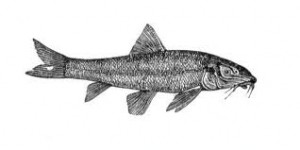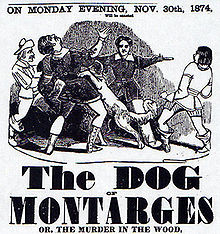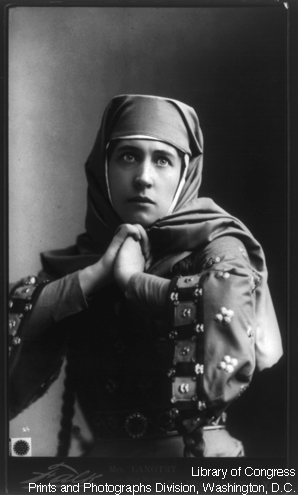
In his article, “Of Fish and Men,” Helmut Müller-Sievers discusses a nineteenth-century biological treatise titled Mémoire sur le système nerveux du barbeau [Memoire on the nervous system of the Barbel fish], published in 1836. The author of that treatise theorizes that, “the entire body of the fish is in fact explicable as a network of correspondences. The nerves correspond to parts of the brain, which in turn correspond to parts of the skull, which again correspond to the vertebrae, which in turn correspond to the nerves, which are themselves analogically related” (713). This notion of the fish as a network of correspondences stemmed from the natural philosophical theories prevalent in Germany during the early nineteenth century. In fact, much of the theory developed in the Mémoire derived from Goethe’s natural-philosophical concept of the Urbild and the Urtyp. For Goethe and others of his (pre-Darwinian) time, “evolution was not yet disrupted by the irreversible catastrophes of selection.” As such, they believed that, “every natural form either harbors the germ of its further development or else harks back to more primitive manifestations of itself” (713). To study the nervous system of the Barbel fish, then, was to penetrate the mysteries of becoming, that is the unfolding of life in the natural world.
Goethe’s concept of Urbild developed from the belief in the existence of a “simple basic pattern, repeating itself over and over again in the natural world” (Price xii). Urtyp, which basically meant “blueprint,” was something that inhered in all natural forms. Naturalists of Goethe’s time believed that the trained eye could perceive this Urtyp within natural forms and that, once observed and then studied, the knowledge first discerned by the eye could transform into knowledge of the simple basic pattern that exists in all living things. The author of the Mémoire, as with Goethe before him, believed that this notion—that a simple form evolved within all living things and that one could learn to perceive this evolution with the eye—led to philosophical revelations. As opposed to the spatial diagnosis of most anatomists—diagnoses that relied on the symmetry of the brain’s two hemispheres, for example, or the symmetry of nerves within the Barbel fish—this notion of Urbild proposed a temporal method of analysis keyed to the metamorphoses of living creatures over time. As such, these theorists challenged Kant’s notion that the human intellect could not perceive time. Time was visible in the becoming of natural life. One need only learn to perceive this unfolding as it unfolded.
Müller-Sievers traces the theories of Goethe and the author of the Mémoire and eventually makes this assertion: “The cold eye of the observer froze and isolated natural forms which were in reality fluid and interconnected. Each form referred to another of which it was, in a general manner, either the germ or the fruit. This network of correspondences found its outer limit in a highly dynamized, and often personalized, concept of nature whose horror was not simply that of the void but of arrest and stillness.” (709). In other words, by ascertaining the process through which all life evolves and changes over time, one actually comes into contact with death, the arrest and stillness of nature that horrifies (and in a certain way titillates) the human observer.
The author of the Mémoire sur le système nerveux du barbeau was none other than Georg Büchner, the author of Danton’s Death, Woyzeck, and other plays (Leonce and Lena), novels (Lenz), and even a political treatise (The Hessian Courier). Victor Price tells us that, “Büchner sent his treatise on the barbel to Lorenz Oken, the natural philosopher, who was professor at the newly founded University of Zürich. Oken found it so impressive that he recommended Büchner for a doctorate without oral examination, and he was offered a post as Privatdozent in the University” (xii). He also tells us that Danton’s Death and this treatise on the barbel fish were the only works by Büchner to be published during his lifetime. In fact: “When Georg Büchner died at twenty-three, his contemporaries, who knew only a garbled version of Danton’s Death, mourned him as one who could have become a great scientist” (vii).
In Theatre History, I used this introduction to Büchner and Danton’s Death as a lure. I intended to attract the attention of my students with something seemingly obscure, off-topic, and irrelevant to the play about the French Revolution I had asked them to read in order to pull them into the mindset of Büchner and his time. After the fish story, I suggested that the distance between the barbel fish and Danton was not as far as it may seem at first. Many of the philosophical notions underpinning Büchner’s Memoire stem from romantic-philosophical ideas developed by people like Goethe, whose Faust, part one, we had just read. Chief among them is the notion that all creation has a common origin and that a thorough and careful observation of any part of creation may give insights into the whole. And yet, Büchner’s writing and thinking marks a distinct shift away from Romanticism. To bring that shift into focus, I drew the students’ attention again to the dialectical relationship between ever-transforming nature and its exact opposite, death, the infinite stillness.*
Büchner’s interest in death (as opposed to striving, the supersensuous, and other Romantic motifs) shows up quite clearly in the words he writes for Danton. We can actually compare some of Büchner’s own words, spoken near the time of his death, and lines from his script. Price tells us that “Three days before his death, after a bout of delirium, [Büchner] said in a calm, solemn voice: ‘We do not have too much pain, we have too little. Because through pain we arrive at God. We are death, dust, ashes. How should we complain?’” (xiii). Two days after uttering this aloud, he died. These words, which infuse the darkness of death with a glimmer of reverence, mirror phrases uttered by the protagonist of Danton’s Death, such as “No, listen. They say there is peace in the grave; the grave and peace are one.” In act one, scene one, after he utters that sweet nothing, Danton continues to ply his lover with this assertion, “I’m already underground when I lie in your lap. Sweet grave, your lips are passing bells, your voice is my knell, your breasts my burial mound and your heart my coffin” (Büchner 5). Is there not something similar between these lines from the play, Büchner’s near-final words, and the study of the Barbel fish? Does Büchner’s fascination with the stillness of death mark a historical shift away form the striving of Faust toward the pleasure principle (and beyond the pleasure principle) of Freud? Isn’t it interesting that a man who devoted his early life to the study of a fish’s nervous system turned his attention to the nervous system of the Revolution?**
I thought it was interesting, and the facial expressions on students in the class seemed to suggest at least a mild interest in the parallel between Büchner-the-scientist and Büchner-the-playwright, whose Woyzeck some of them were familiar with after our Department’s recent production. More interesting, however, were the lines of inquiry that emerged after the class. One of my students asked for more information about Büchner’s fiancée, Minna Jaegle. I had mentioned her name only in passing, but the brief mention was enough to set the wheels turning. Another student felt lost after the lecture and decided to do some historical research on the real-life Danton and Robespierre. Our in-class conversation covered the rise of Sturm und Drang, the emergence of the German state theatres, and the appearance of the Young Germans, but I had not discussed the French Revolution in any depth, so this student took matters into her own hands. Eventually, she emailed me to say that her research made the play much clearer. This student even suggested that in the future I provide information about the historical figures that make appearances in Büchner’s play. I thanked her for the suggestions and told her that I would take that into consideration, but that I much prefer for her to complement our in-class discussions with her own research.
From fish to Büchner to Minna Jaegle to the historical Danton and Robsepierre: this was week three in Theatre History. I’m curious to know how other people handle Büchner when they teach this time period, or if people handle him at all. Price suggests that he never saw one word of his uttered upon a stage and that there is no evidence to suggest that he ever went to the theatre. Lines from Danton’s Death, particularly Camille’s rant against puppet shows in act two, scene three, seem to suggest he had. Still, it wouldn’t surprise me if teachers skip over him altogether because of the overly-literary quality of his plays. Please share your thoughts on Büchner. I’d love to hear them.
Notes:
* I have read that Büchner was openly hostile to Hegel’s system of the dialectic. To me, however, it seems that perhaps Büchner had internalized the dialectical logic and rebelled against Hegel’s insistence on the eventual resolution between opposites. It might be worthwhile to study Büchner as a forerunner to the theory of negative dialectics.
** Though the French Revolution of 1789 was the focus on Danton’s Death, it is probable that the failed July Revolution of 1830 in France and the semi-uprising in Poland against Russian authorities were present in his mind.
Sources:
Müller-Sievers, Helmut. “Of Fish and Men: The Importance of Georg Büchner’s Anatomical Writings.” MLN vol 118 no. 3 (April 2003): 704-718.
Price, Victor. “Introduction.” Georg Büchner, Danton’s Death, Leonce and Lena, and Woyzeck. Oxford, England: Oxford University Press, 2008.



